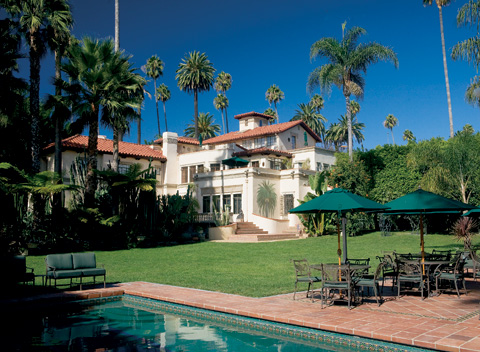The Legendary Estates of Beverly Hills takes readers inside the front gates and behind the hedges of 50 of America’s most coveted estates. More than 350 color photographs offer readers never-before-seen views of these mansions, their interiors, and their grounds and gardens today.
This 428-page, 12-inch by 16-inch book’s authoritative text reveals the fascinating histories of each estate, from the inspired vision of the original owners and their architects, to the often-surprising lives of the many famed residents, including their intrigues, tragedies, and romances. Historical photographs pay homage to a dozen “Gone But Not Forgotten” estates that have disappeared forever.
Never before has a book offered such an intimate, well-researched, and alluring look at these much-admired estates, which have been homes to countless celebrities and wealthy families for almost a century. www.thelegendaryestatesofbeverlyhills.com
Jeffrey Hyland is president of Hilton & Hyland, the preeminent real estate brokerage firm in Beverly Hills. www.hiltonhyland.com
Powerful Hollywood mogul Sol Wurtzel wanted Neff to design his new mansion in Bel-Air.
Bellagio Road
Bel-Air
In August 1930, famed architect Wallace Neff received a telephone call that he would never forget. Powerful Hollywood mogul Sol Wurtzel wanted Neff to design his new mansion in Bel-Air.
Neff knew that the Wurtzels would be a “handful.” Sol Wurtzel, general superintendent of Fox Pictures, was a feared, take-no-prisoners studio mogul. Marian Wurtzel was temperamental and opinionated, and she would have plenty of time to meddle in the new home’s design and construction.
Neff took the job, because Southern California’s once-robust economy had contracted painfully after the 1929 stock market crash. Moreover, the mansion’s budget was $100,000, a huge sum in Depression-era dollars.
The Wurtzel commission proved to be the headache that Neff had anticipated, but Marian was more difficult than her feared husband. Their disagreements about the estate were never-ending. “It’s been a long, tough battle with your mother,” Sol wrote to his daughter at school in Paris, “but I finally won out.”
The Italian Renaissance mansion, true to Neff’s form, was a masterpiece. The front door led into a very large-and very grand-oval reception room with the curving grand staircase on one side. To the right was the huge living room with French doors leading to the arched loggia. To the left of the reception room was the dining room and breakfast room, both opening onto their loggia, and the kitchen and service wing. The second floor contained the library and four master bedrooms. (In 1939, Neff added a magnificent terrace, swimming pool, and loggia on flat land just west of the main house.)
Marian, who loved to spend money, furnished the mansion with reproduction antique furniture, purchased fine English silver for their dinner parties, and secured crystal chandeliers during one trip to Italy. She bought furs and jewels for herself. She imagined herself an artist-she loved to paint pictures while sitting on the loggias-and she hung some of her favorite works throughout the mansion.
Meanwhile, Sol earned the money to pay for the Bellagio Road establishment. He churned out an endless string of “B” movies, chiefly murder mysteries. One wag quipped that the output at the Fox studio was “going from bad to Wurtzel.”
When Marian learned that one of the Fox starlets was going to have Sol’s child, she stormed off to Europe. He begged her to return. She refused. Later, the contentious couple reconciled, and they were still married when he died in 1958.
By then, they had already sold their Bel-Air estate, which had a series of famous residents: eccentric aviation pioneer Howard Hughes; Prince Rainier of Monaco, who lived at the estate while he was courting Grace Kelly prior to their 1956 marriage; and Elvis Presley, who needed a home while he was making some of his popular films in the early 1960s.
Word of Elvis Presley living in Bel-Air quickly spread among his fans. In February 1961, two Bel-Air teenager girls snuck onto the estate and into the mansion while Presley was out of town, and they stole some of his sweaters, jackets, a black kimono, photographs, and records. Their parents discovered their daughters’ loot, and the “souvenirs” were returned to Presley.
The current owners of this estate have always admired its beauty, and their improvements have only enhanced its magnificence. Today, the estate is one of the prized properties of Old Bel-Air.
Foothill Road
Beverly Hills
In Beverly Hills, almost all the Legendary Estates are located in the hills above famed Sunset Boulevard…with one splendid exception: this 1920s estate on palm-lined Foothill Road in the Beverly Hills “flats.”
This mansion’s wrought-iron balconies, beautiful cast-stone embellishments, and a soaring trifoliate window give the residence the exotic air of a land-locked Venetian palazzo. Its interior is richly embellished with black and white marble floors, more elaborate wrought iron, colorful hand-painted tiles, and boldly stenciled beams.
This estate was the wedding gift of Beverly Hills Realtor James Cornelius to his wife, Ruth Clifford, following their 1924 marriage. While forgotten today, the petite attractive Ruth Clifford was one of the brightest stars in 1920s Hollywood.
If this were a movie, the couple would have lived happily ever after. But, alas, they didn’t. By 1926, the couple started nearly a decade of on-again/off-again separations and reconciliations.
Meanwhile, neighbors were gossiping about the underground tunnels connecting the estate to the adjacent properties to the north and south. Who built the tunnels-and why? Prohibition. The underground ballroom, speakeasy, and concealed bar allowed for quick exits to neighboring properties they owned when the cops were called. In fact, there was more square footage below ground, with the steam room, bathrooms, and hideaways, than were contained on the two levels above ground.
In 1934, Ruth filed for divorce because of her husband’s infidelities. When it was time to determine child support, Cornelius tearfully claimed that he was dependent on his mother for money. The judge believed him, and Ruth was awarded $75 a month.
Although Ruth left the Foothill Road estate in the early 1930s, she had the last laugh. She worked in films, TV, and theater into the 1960s and 1970s. She was even, upon occasion, the voice of Minnie Mouse in Walt Disney cartoons. Before her death in 1998 at age 98, she had become a revered living landmark of early Hollywood. Every year, journalists and historians made pilgrimages to her home to learn about the golden age of silent film.
Back on Foothill Road, Ruth’s home had various owners and tenants during the 1930s and 1940s. In the 1950s, new owners purchased the property, and it remains in their family today, a splendidly preserved reminder of 1920s Beverly Hills.





















